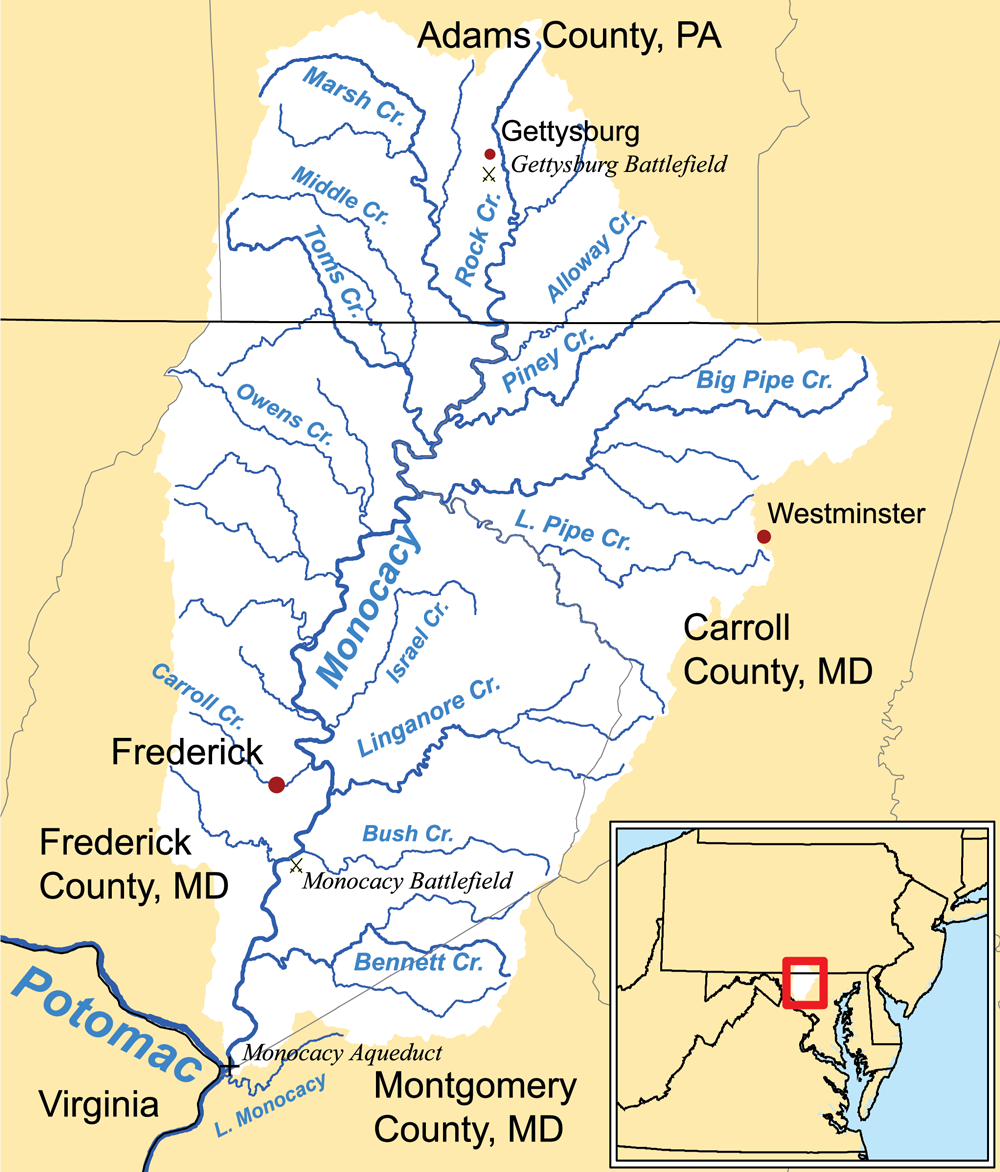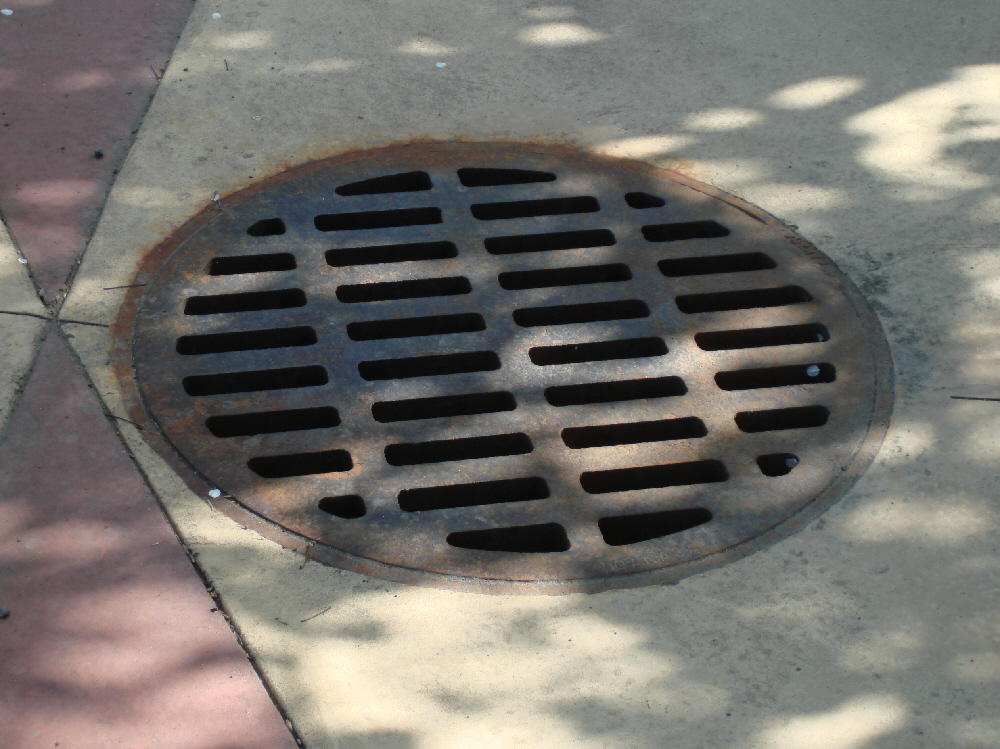|
Double Pipe Creek
Double Pipe Creek, sometimes called Pipe Creek, is a major tributary of the Monocacy River in Carroll County and Frederick County in Maryland, located several miles north and west of Westminster. The creek is only long,U.S. Geological Survey. National Hydrography Dataset high-resolution flowline dataThe National Map, accessed August 15, 2011 but is formed by the confluence of two much longer streams, Big Pipe Creek and Little Pipe Creek. Course The creek's watershed extends as far east as Manchester, Maryland, and includes the towns of Union Bridge, Taneytown, New Windsor and Westminster. The main stem of the creek is formed from the confluence of Big Pipe Creek, long, with headwaters near Manchester; and Little Pipe Creek, long, with headwaters in Westminster. From the confluence, near Detour, Maryland (), Double Pipe flows west for to its mouth at the Monocacy, which drains to the Potomac River. The watershed area of Double Pipe Creek is . Tributaries include Bear Branch ... [...More Info...] [...Related Items...] OR: [Wikipedia] [Google] [Baidu] |
Monocacy River
The Monocacy River () is a free-flowing left tributary to the Potomac River, which empties into the Atlantic Ocean via the Chesapeake Bay. The river is long,U.S. Geological Survey. National Hydrography Dataset high-resolution flowline dataThe National Map , accessed August 15, 2011 with a drainage area of about . It is the largest Maryland tributary to the Potomac. The name "Monocacy" comes from the Shawnee name for the river ''Monnockkesey'', which translates to "river with many bends." (However, another local tradition asserts that "Monocacy" means "well-fenced garden" in an Indian language.) The first town ever settled in Western Maryland, Monocacy, also gets its name from this river. The Monocacy National Battlefield lies alongside part of the river, marking an 1864 engagement during the American Civil War, the Battle of Monocacy Junction. The Chesapeake and Ohio Canal crosses over the river at the Monocacy Aqueduct, the largest of the 11 aqueducts on the canal. Geo ... [...More Info...] [...Related Items...] OR: [Wikipedia] [Google] [Baidu] |
Monocacy
Monocacy (Shawnee language, Shawnee: ''Monnockkeseymay'') may refer to the Monocacy River in Maryland, USA. Monocacy may also refer to: Other streams *Little Monocacy River, a tributary of the Potomac River in Maryland *Monocacy Creek (Lehigh River tributary), a tributary of the Lehigh River in Pennsylvania *Monocacy Creek (Schuylkill River), a tributary of the Schuylkill River in Pennsylvania Ships *USS Monocacy (1864), the first ''Monocacy'', a gunboat launched in, and served until 1903 *USS Monocacy (PG-20), the second ''Monocacy'', commissioned in 1914 and decommissioned in 1939 *USS Genesee (AT-55), originally the civilian tug ''Monocacy'' (1905) Other *Monocacy Aqueduct, crosses the Monocacy River near its mouth *Monocacy National Battlefield, memorializing the Battle of Monocacy (1864), fought near the Monocacy River *Battle of Monocacy, the July 1864 Civil War battle *Monocacy (MARC station) named for the battlefield site *Monocacy Station, Pennsylvania, an unincorpor ... [...More Info...] [...Related Items...] OR: [Wikipedia] [Google] [Baidu] |
Sediment
Sediment is a naturally occurring material that is broken down by processes of weathering and erosion, and is subsequently transported by the action of wind, water, or ice or by the force of gravity acting on the particles. For example, sand and silt can be carried in suspension in river water and on reaching the sea bed deposited by sedimentation; if buried, they may eventually become sandstone and siltstone (sedimentary rocks) through lithification. Sediments are most often transported by water (fluvial processes), but also wind (aeolian processes) and glaciers. Beach sands and river channel deposits are examples of fluvial transport and deposition, though sediment also often settles out of slow-moving or standing water in lakes and oceans. Desert sand dunes and loess are examples of aeolian transport and deposition. Glacial moraine deposits and till are ice-transported sediments. Classification Sediment can be classified based on its grain size, grain shape, and c ... [...More Info...] [...Related Items...] OR: [Wikipedia] [Google] [Baidu] |
Alternate History
Alternate history (also alternative history, althist, AH) is a genre of speculative fiction of stories in which one or more historical events occur and are resolved differently than in real life. As conjecture based upon historical fact, alternative history stories propose ''What if?'' scenarios about crucial events in human history, and present outcomes very different from the historical record. Alternate history also is a subgenre of literary fiction, science fiction, and historical fiction; as literature, alternate history uses the tropes of the genre to answer the ''What if?'' speculations of the story. Since the 1950s, as a subgenre of science fiction, alternative history stories feature the tropes of time travel between histories, and the psychic awareness of the existence of an alternative universe, by the inhabitants of a given universe; and time travel that divides history into various timestreams. In the Spanish, French, German, and Portuguese, Italian, Catalan, and ... [...More Info...] [...Related Items...] OR: [Wikipedia] [Google] [Baidu] |
Army Of The Potomac
The Army of the Potomac was the principal Union Army in the Eastern Theater of the American Civil War. It was created in July 1861 shortly after the First Battle of Bull Run and was disbanded in June 1865 following the surrender of the Confederate Army of Northern Virginia in April. History The Army of the Potomac was created in 1861 but was then only the size of a corps (relative to the size of Union armies later in the war). Its nucleus was called the Army of Northeastern Virginia, under Brig. Gen. Irvin McDowell, and it was the army that fought (and lost) the war's first major battle, the First Battle of Bull Run. The arrival in Washington, D.C., of Maj. Gen. George B. McClellan dramatically changed the makeup of that army. McClellan's original assignment was to command the Division of the Potomac, which included the Department of Northeast Virginia under McDowell and the Department of Washington under Brig. Gen. Joseph K. Mansfield. On July 26, 1861, the Department of the S ... [...More Info...] [...Related Items...] OR: [Wikipedia] [Google] [Baidu] |
George Meade
George Gordon Meade (December 31, 1815 – November 6, 1872) was a United States Army officer and civil engineer best known for decisively defeating Confederate States Army, Confederate Full General (CSA), General Robert E. Lee at the Battle of Gettysburg in the American Civil War. He previously fought with distinction in the Second Seminole War and the Mexican–American War. During the Civil War, he served as a Union Army, Union General officer, general, rising from command of a brigade to that of the Army of the Potomac. Earlier in his career, he was an engineer and was involved in the coastal construction of several lighthouses. Meade's Civil War combat experience started as a brigade commander (brigadier general) in the Peninsula Campaign and the Seven Days Battles. He was severely wounded while leading his brigade at the Battle of Glendale. As a division commander, he had notable success at the Battle of South Mountain and assumed temporary corps command at the Battle o ... [...More Info...] [...Related Items...] OR: [Wikipedia] [Google] [Baidu] |
Battle Of Gettysburg
The Battle of Gettysburg () was fought July 1–3, 1863, in and around the town of Gettysburg, Pennsylvania, by Union and Confederate forces during the American Civil War. In the battle, Union Major General George Meade's Army of the Potomac defeated attacks by Confederate General Robert E. Lee's Army of Northern Virginia, halting Lee's invasion of the North. The battle involved the largest number of casualties of the entire war and is often described as the war's turning point due to the Union's decisive victory and concurrence with the Siege of Vicksburg.Rawley, p. 147; Sauers, p. 827; Gallagher, ''Lee and His Army'', p. 83; McPherson, p. 665; Eicher, p. 550. Gallagher and McPherson cite the combination of Gettysburg and Vicksburg as the turning point. Eicher uses the arguably related expression, " High-water mark of the Confederacy". After his success at Chancellorsville in Virginia in May 1863, Lee led his army through the Shenandoah Valley to begin his second ... [...More Info...] [...Related Items...] OR: [Wikipedia] [Google] [Baidu] |
Union Mills Reservoir
A proposed Union Mills Reservoir represents a half century of efforts by the Commissioners of the Carroll County, Maryland, to build variations on a "dam" or "reservoir" near Union Mills, Maryland, on the Big Pipe Creek, defeated by a petition led by the Carroll County Taxpayers' Committee in the 1970s. The plan may be alive among some county officials but may also be postponed "indefinitely." Land threatened by the reservoir includes the Whittaker Chambers Farm, also known as the Pipe Creek Farm, a National Historic Landmark as well as protected under the Maryland Agricultural Land Preservation Foundation (MALPF). Description According to a county report from the mid-1970s, the reservoir "will provide storage for sediment (1,125 acre-feet), flood control (6,414 acre-feet) municipal water supply (4,235 acre-feet) and recreation (1,210 acre-feet)." The reservoir would need 325 acres. As for 2014, Carroll County government's plan was to have a Union Mills Reservoir prov ... [...More Info...] [...Related Items...] OR: [Wikipedia] [Google] [Baidu] |
Urban Runoff
Urban runoff is surface runoff of rainwater, landscape irrigation, and car washing created by urbanization. Impervious surfaces (roads, parking lots and sidewalks) are constructed during land development. During rain , storms and other precipitation events, these surfaces (built from materials such as asphalt and concrete), along with rooftops, carry polluted stormwater to storm drains, instead of allowing the water to percolate through soil. This causes lowering of the water table (because groundwater recharge is lessened) and flooding since the amount of water that remains on the surface is greater.Water Environment Federation Alexandria, VA; an American Society of Civil Engineers Reston, VA [...More Info...] [...Related Items...] OR: [Wikipedia] [Google] [Baidu] |
Surface Runoff
Surface runoff (also known as overland flow) is the flow of water occurring on the ground surface when excess rainwater, stormwater, meltwater, or other sources, can no longer sufficiently rapidly infiltrate in the soil. This can occur when the soil is saturated by water to its full capacity, and the rain arrives more quickly than the soil can absorb it. Surface runoff often occurs because impervious areas (such as roofs and pavement) do not allow water to soak into the ground. Furthermore, runoff can occur either through natural or man-made processes. Surface runoff is a major component of the water cycle. It is the primary agent of soil erosion by water. The land area producing runoff that drains to a common point is called a drainage basin. Runoff that occurs on the ground surface before reaching a channel can be a nonpoint source of pollution, as it can carry man-made contaminants or natural forms of pollution (such as rotting leaves). Man-made contaminants in runoff i ... [...More Info...] [...Related Items...] OR: [Wikipedia] [Google] [Baidu] |
Livestock
Livestock are the domesticated animals raised in an agricultural setting to provide labor and produce diversified products for consumption such as meat, eggs, milk, fur, leather, and wool. The term is sometimes used to refer solely to animals who are raised for consumption, and sometimes used to refer solely to farmed ruminants, such as cattle, sheep, goats and pigs. Horses are considered livestock in the United States. The USDA classifies pork, veal, beef, and lamb (mutton) as livestock, and all livestock as red meat. Poultry and fish are not included in the category. The breeding, maintenance, slaughter and general subjugation of livestock, called '' animal husbandry'', is a part of modern agriculture and has been practiced in many cultures since humanity's transition to farming from hunter-gatherer lifestyles. Animal husbandry practices have varied widely across cultures and time periods. It continues to play a major economic and cultural role in numerous communities. Lives ... [...More Info...] [...Related Items...] OR: [Wikipedia] [Google] [Baidu] |









